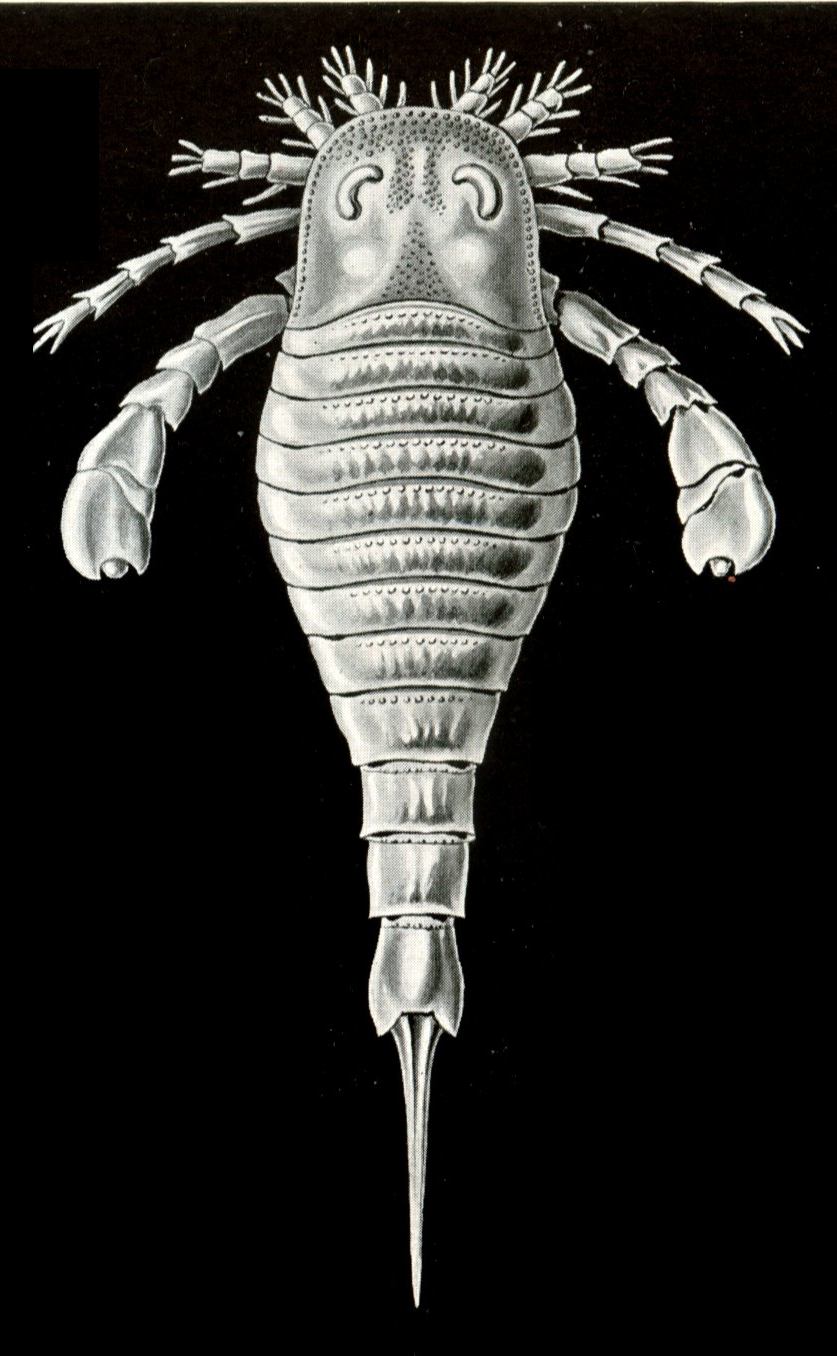Eurypterid, Sea Scorpion (Class: Eurypterida) - Wiki Eurypterid
From Wikipedia, the free encyclopedia
Scientific classification
Kingdom: Animalia
Phylum: Arthropoda
Subphylum: Chelicerata
Class: Eurypterida
[Photo] Eurypterid. From the 47th plate from Ernst Haeckel's Kunstformen der Natur (1904). See http://commons.wikimedia.org/wiki/Image:Haeckel_Aspidonia.jpg for the full plate.
The eurypterid (sea scorpion) was the largest known arthropod that ever lived (with the possible exception of Arthropleuridae). They are members of the extinct class Eurypterida (Arachnomorpha, Chelicerata) and predate the earliest fishes. The largest, such as Pterygotus, reached 2 m or more in length, but most species were less than 20 cm. They were formidable predators that thrived in warm shallow water in the Cambrian to Permian from 510 to 248 million years ago. Although called "sea scorpions", only the earliest ones were marine (most lived in brackish or freshwater), and they were not true scorpions. The move from the sea to fresh water probably occurred by the Pennsylvanian period.
Eurypterus is perhaps the most well-known genus of eurypterid, of which 200 fossil species are known. The genus Eurypterus was created in 1825 by James Ellsworth DeKay, a zoologist. He recognized the arthropod nature of the first ever described eurypterid specimen found by Dr. S. L. Mitchell. In 1984, Eurypterus remipes was named the State Fossil of New York.
Body structure
The typical eurypterid had a large, flat, semicircular carapace, followed by a jointed section, and finally a tapering, flexible tail, most ending with a long spine at the end ( Pterygotus, though, had a large flat tail, possibly with a smaller spine). Behind the head of the eurypterids were twelve body segments. These segments are formed by a dorsal plate called tergite, and a ventral plate called sternite. The tail, known as the telson, is spiked in most eurypterids like in modern scorpions and in some species it possibly may have been used to inject venom, but so far there is no certain evidence any eurypterids were venomous. Most eurypterids have paddles toward the end of the carapace and beyond, which were used to propel themselves through water. Some argue that the paddles were also used for digging. It is possible that it was used for both. Underneath, in addition to the pair of swimming appendages the creature had 4 pairs of jointed legs for walking, and two small claws at the front, chelicerae. The walking legs had odd hairs on it, similar to modern day crabs. Other features, common to ancient and modern arthropods of this type, include one pair of compound eyes and a pair of smaller eyes called ocelli, in between the other larger 2 eyes.
Although many eurypterids had legs too tiny to do more than allow them to crawl over the sea bottom, a number of forms had large stout legs, and were clearly capable of terrestrial locomotion (like land crabs today). While functional studies suggest that eurypterids used out-of-phase walking techniques, their trackways indicate that they used in-phase, hexapodous (six-legged) and octopodous (eight-legged) gaits. Some species may have been amphibious, emerging onto land for at least part of their life cycle. They may have been capable of breathing both in water and in air.
The largest species of sea-scorpion was Pterygotus, an arthropod the size of a crocodile. Fossils of Pterygotus are relatively common although complete fossils are rare. They may have preyed upon Brontoscorpio and Cephalaspis. At 2.8 meters long, they are the largest known arthropod ever to have lived. Their fossils have been found worldwide, except in Antarctica. Arthropleura came close in size, growing to slightly over 2 meters long.
They had traditionally been considered close relatives to the common Horseshoe Crab, but most recent evidence places them closer to the arachnids.
Eurypterid fossils
Eurypterid fossils have a near global distribution. Among the largest eurypterids are the Hibbertopterina, named after the British palaeontolgist S. Hibbert, who described Hibbertopterus scouleri at a limestone quarry in East Kirkton, Scotland, in 1836. Fossil tracks (a form of trace fossil) were identified recently in East Lothian, Scotland, as made by a 1.6 meter long Hibbertopterus (Whyte, 2005).
Eurypterids are related to the modern marine horseshoe crabs. About two dozen families of eurypterids are known. They went extinct during the Permian-Triassic extinction event 251.4 million years ago. A predatory arthropod known as Protichnites, found in Cambrian strata dating from 510 million years ago, is a possible stem group eutrypterid, and was one of the first animals to walk on land.
http://en.wikipedia.org/wiki/Eurypterid
| The text in this page is based on the copyrighted Wikipedia article shown in above URL. It is used under the GNU Free Documentation License. You may redistribute it, verbatim or modified, providing that you comply with the terms of the GFDL. |
